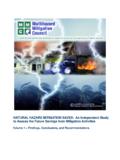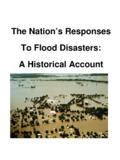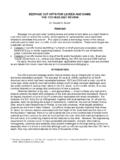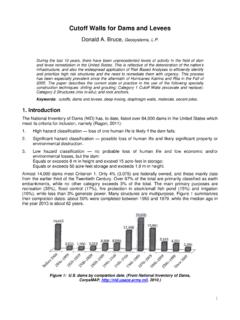Transcription of A COMPARATIVE LOOK AT PUBLIC LIABILITY FOR …
1 1 A COMPARATIVE look AT PUBLIC LIABILITY FOR FLOOD HAZARD MITIGATION By Dr. Jon A. Kusler, Esq. Prepared for the Association of State Floodplain Managers Foundation 2 FOREWORD This paper takes a COMPARATIVE look at government LIABILITY for flood hazard mitigation measures. The term mitigation is broadly used in the paper to include hazard reduction measures such as dams , levees and other structures. Mitigation measures also include loss reduction efforts such as flood hazard mapping, warning systems, evacuation planning, and floodplain regulations such as zoning and building codes. The paper briefly considers, as well, suits against government to compel payment of disaster assistance and government flood insurance.
2 This paper is one of a series of papers concerning flood-related LIABILITY prepared by the author and Ed Thomas, Esq. with support from the Association of State Floodplain Managers Foundation. These also include papers dealing with no adverse impact floodplain management, LIABILITY for levees and dams , and professional LIABILITY for construction in flood hazard areas. See This paper addresses topics not extensively covered by earlier papers. It begins with a comparison of LIABILITY for the full range of hazard reduction and loss reduction measures. It next considers various factors considered by the courts in determining whether a government is liable for flood or erosion losses. It then considers the LIABILITY implications of various steps or stages in government hazard and loss reduction.
3 It next considers case law addressing individual hazard reduction and loss reduction measures. It concludes with recommendations for governments to avoid or reduce potential LIABILITY . This paper attempts to simplify a complicated subject. An effort has been made to make the paper understandable by nonlawyers while, simultaneously, providing many footnotes to court cases for the lawyers. DISCLAIMER The paper does not provide legal advice for your state. For legal advice including the status of statutory and case law in your jurisdiction consult a lawyer licensed in your state. The paper describes the general status of law throughout the nation and not that of a particular jurisdiction. It reflects our own opinions concerning the content of cases and trends in the law.
4 It, should, therefore, be used with care. 3 ACKNOWLEDGEMENTS This paper has been prepared with funding support from the Association of State Floodplain Managers Foundation. It draws upon other studies by the author including a book to be published in 2009: Jon Kusler, PUBLIC LIABILITY for Floods and Other Natural Hazards. This funding support from the Foundation for the following paper and two earlier papers by the author and Ed Thomas which are available on the Association of State Floodplain Managers web site, , is gratefully acknowledged. The encouragement and help of Ed Thomas and Larry Larson are particularly appreciated. 4 SUMMARY Over the last four decades, governments have broadly adopted flood loss reduction measures including both structural measures (dikes, dams , levees , grounds, stormwater systems) and nonstructural measures (building codes, land use planning, flood predictions, warning systems, other).
5 These measures have, to a greater or lesser extent, resulted in law suits when flood or erosion losses do occur. In addition, landowners have sued governments in some instances for floodplain regulations, claiming an unconstitutional taking of private property or that permits to build have increased flooding on their properties. To what extent and in what contexts have governments been held liable for undertaking structural and nonstructural flood loss reduction measures under negligence, trespass, strict LIABILITY , nuisance, inverse condemnation or other legal theories? Are successful suits more common for some measures than others? Why? What factors contribute to successful and unsuccessful suits?
6 How may governments reduce the potential for successful suits? COMPARATIVE Overview of LIABILITY LIABILITY for structural measures: Courts have often held governments liable for increasing flood or erosion hazards on adjacent lands by grading or filling land or by constructing structural hazard reduction measures such as dikes, dams , and levees . Although often intended to reduce flood losses, structural measures increase flood losses in some circumstances, particularly when design frequencies are exceeded or measures are inadequately designed, constructed, operated, or maintained. When injuries occur, private landowners and other members of the PUBLIC increasingly sue governments for economic flood damages and in some instances pain, and suffering.
7 Many successful suits have targeted ministerial government actions during the construction or administration phases of structural projects such as failure to maintain ditches and storm water facilities. With regard to LIABILITY for structural measures, courts have more specifically often found governments: --Strictly liable for constructing dams which collapse due to inadequate design, construction, operation or maintenance. They have also found governments liable for negligence or a taking of property due to seepage caused by dams . --Liable for negligence in the design (in some instances), construction, maintenance and operation of groins, sea walls, levees , bridges, and stormwater facilities which increase flooding or erosion on private properties.
8 5 LIABILITY for nonstructural measures (other than regulations). Courts have held governments liable in small number of cases for nonstructural loss reduction measures such as inadequate flood warnings, inadequate dissemination of flood information, and other nonstructural flood loss reduction measures. Few of these cases have succeeded due to explicit LIABILITY exemptions in state tort claim and emergency management statutes, because government has no duty to provide benefits , and because many of these measures such as weather prediction involve a great deal of discretion. With regard to LIABILITY for nonstructural measures, courts have more specifically: --Not found governments liable for weather and flood forecasts because of the large amount of discretion involved in making such forecasts.
9 --In only a few cases found governments liable for inadequate dissemination of weather or flood forecast information. --Not found governments liable for inadequate flood maps. --In only a few cases found governments liable for inadequate emergency management activities. LIABILITY for regulations. Courts have held governments liable in even a smaller number of cases for taking private property without payment of just compensation through adoption, administration and enforcement of floodplain regulations or refusing to issue permits pursuant to regulations. However, some courts have also held governments liable for negligence or nuisances when governments issue regulatory permits for buildings, other structures, or subdivisions which cause increased flood hazards on other property.
10 This is particularly true where governments not only approve but accept dedications of stormwater, flood control and other facilities. More specifically, courts have: --Strongly and universally supported performance-oriented floodplain regulations against takings claims. --Broadly supported regulations which exceed minimum Federal Emergency Management Agency (FEMA) standards including flood protection elevations which exceed FEMA requirements, floodway designations ( , zero rise), and beach and river setbacks. Courts have only held highly restrictive floodplain regulations a taking in a few cases in which the regulations denied all economic use of entire parcels. --In some jurisdictions, held governments liable for negligence or nuisances when governments issue regulatory permits for buildings, other structures, or subdivisions which cause increased flood hazards on other property or for inadequate inspections or monitoring.












